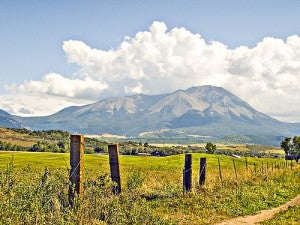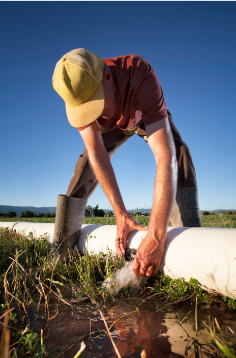 This post was co-written by Mark Harris, general manager for the Grand Valley Water Users’ Association.
This post was co-written by Mark Harris, general manager for the Grand Valley Water Users’ Association.
In a recent op-ed, the Colorado Forum – a nonpartisan organization of CEOs and civic leaders – delivered a powerful message to Governor Hickenlooper, who is drafting a first-ever Colorado Water Plan to confront the state’s growing water demands.
The forum’s message: we must all work together to secure a water future that keeps Colorado a world class place to live, visit, work and play.
The forum made a handful of recommendations in the article, but one stood out to us as particularly relevant as we attempt to balance many competing interests in a single water plan: agriculture must be given the freedom and opportunity to thrive in Colorado’s water future.
A huge stake in the plan
As the forum noted, “Our agricultural sector uses and reuses the great majority of the state’s water to fuel a vibrant agricultural economy.”
Being in an industry so heavily dependent on water, farmers and ranchers are keenly aware of the effects that shortage and variability can have and will have in the future. They have been building weather risk into their business planning for decades and are used to dealing with environmental uncertainty.
However, farmers and ranchers can also be the best stewards of our natural resources when they are able to reduce non-environmental uncertainties and produce at the highest efficiency and profitability. Because of this, farmers may have the most to gain from a truly sustainable and flexible water plan that can bring some measure of additional certainty to their businesses.
That’s why they have been fully engaged in the Governor’s process, going so far as to recommend their own set of water principles that they would like to see in the plan. Here are two of their recommendations.
1. Remove the obstacles to innovation
Colorado water law is complex and slow to evolve. Currently, there are too few incentives for irrigators to innovate. Despite this, farmers and ranchers have been leaders in conservation and efficiency for generations, so the water plan should provide them with the freedom to continue to lead.
This might take the form of new legal incentives – like alternative transfer and efficiency programs to monetize partial and temporary water savings – or even creative insurance programs to help offset risks from testing new technologies and practices.

“Water is essential to our farm,” says Paul Kehmeier, who manages his family farm near Eckert, Colo. “If we don’t irrigate, our farm is a desert.”
The water plan should strive to overcome obstacles to innovation by including incentives to improve agricultural resiliency and profitability. Greater flexibility should be embedded in emerging water markets to make innovative water sharing programs more attractive.
Similarly, many conservation and efficiency improvements can be designed to improve environmental values while also supporting the long-term viability of both cities and agricultural communities. Such programs need to be better understood and incentives developed to encourage the maintenance and improvement of our valuable water resources.
2. Invest in water efficiency projects
In some areas of the state, it is very difficult for irrigators to justify the high capital costs of efficiency improvements due to the modest increases in productivity that they can provide. However, in the long term, these efficiencies can translate into critical water supply resiliency for farmers and ranchers in drier and more variable periods that may quite literally keep them on the land if climate projections are accurate.
Since these improvements benefit rural economies, rivers and cultural values, increased public and private investment in improving water efficiency and infrastructure is an important first step to securing both agricultural and water sustainability in Colorado.
The public sector continues to support agricultural infrastructure through a number of existing programs, such as USDA-NRCS Farm Bill programs like the Environmental Quality Incentives Program and Bureau of Reclamation WaterSMART Program. These are as critical today as they were when they were first created; but they, too, may need to adapt to climate change and drought along with the irrigators they support.
On the other side, private investors will expect some form of return and those negotiations will inevitably be difficult. More open discussion is needed to determine whether agreements can be made that improve agricultural resiliency and profitability in ways that generate both financial returns and public benefits.
Helping farmers helps Colorado
When you figure that agriculture contributes more than $7 billion to the Colorado state economy annually and more than 105,000 jobs in Colorado are related to agribusiness, it becomes even clearer that investing in the long-term viability of Colorado’s ag sector is an investment in the long-term viability of Colorado.
We hope that farmers’ voices are heard by the Governor’s office and reflected in the final draft of the State Water Plan.










